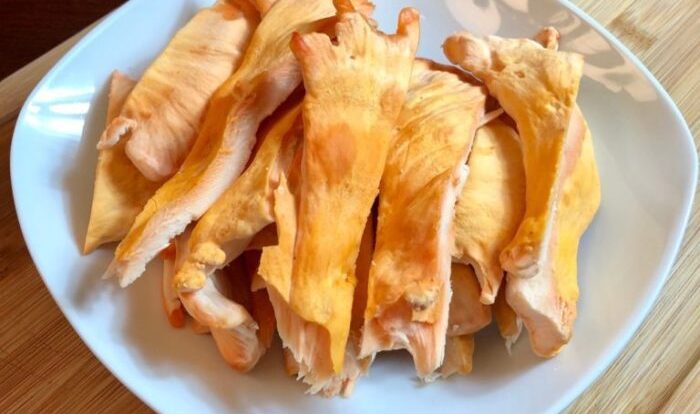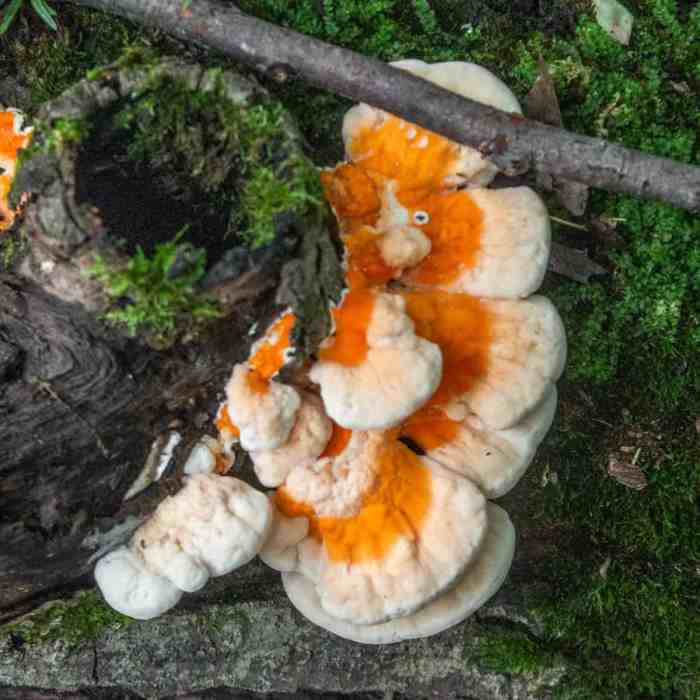
Chicken of the woods recipe – Embark on a culinary adventure with our comprehensive guide to Chicken of the Woods, a wild mushroom that tantalizes taste buds and inspires culinary creativity. From harvesting and preparation to delectable recipes and health benefits, this guide unravels the secrets of this versatile ingredient, empowering you to elevate your cooking game.
Discover the captivating world of Chicken of the Woods, a vibrant and flavorful mushroom that graces forests worldwide. Its unique appearance, culinary versatility, and nutritional value make it a beloved choice among mushroom enthusiasts and adventurous eaters alike.
Introduction to Chicken of the Woods
Chicken of the Woods is a wild mushroom that has a unique appearance and a delicious, meaty flavor. It is a popular edible mushroom that is often found growing on dead or dying oak trees.
Chicken of the Woods is a large mushroom that can grow up to 12 inches in diameter. It has a bright orange or yellow cap that is covered in small, velvety pores. The flesh of the mushroom is white and firm, and it has a mild, nutty flavor.
If you’re looking for a delicious and unique way to enjoy mushrooms, check out this chicken of the woods recipe . This edible fungus is known for its meaty texture and earthy flavor, making it a great substitute for chicken in a variety of dishes.
Whether you’re new to cooking with mushrooms or a seasoned pro, this recipe is sure to impress your taste buds.
Nutritional Value
Chicken of the Woods is a good source of protein, fiber, and vitamins. It is also low in calories and fat. One cup of cooked Chicken of the Woods contains:
- Calories: 25
- Protein: 3 grams
- Fiber: 2 grams
- Vitamin C: 10% of the daily recommended value
- Potassium: 5% of the daily recommended value
Culinary Uses
Chicken of the Woods is a versatile mushroom that can be used in a variety of dishes. It can be sautéed, roasted, grilled, or fried. It is also a good addition to soups, stews, and casseroles.
Species of Chicken of the Woods
There are several different species of Chicken of the Woods, each with its own unique flavor and appearance. Some of the most common species include:
- Laetiporus sulphureus: This is the most common species of Chicken of the Woods. It has a bright orange cap and a mild, nutty flavor.
- Laetiporus cincinnatus: This species has a yellow cap and a slightly more pungent flavor than L. sulphureus.
- Laetiporus conifericola: This species grows on coniferous trees and has a dark orange cap.
Harvesting and Preparing Chicken of the Woods

Harvesting Chicken of the Woods requires specific knowledge and techniques to ensure the mushroom’s freshness and safety. Here’s a comprehensive guide to harvesting and preparing this delicious delicacy.
Harvesting Chicken of the Woods
The optimal time to harvest Chicken of the Woods is during the late summer and early fall months. Look for the mushroom in moist, shady areas near oak trees or stumps. When harvesting, use a sharp knife to cut the mushroom at the base, leaving the root intact to allow for future growth.
Cleaning and Preparing Chicken of the Woods, Chicken of the woods recipe
Once harvested, Chicken of the Woods should be cleaned thoroughly to remove any debris or insects. Use a soft brush or damp cloth to gently wipe the mushroom’s surface. Avoid using water, as it can make the mushroom soggy. If necessary, cut away any tough stems or discolored areas.
Cooking Methods for Chicken of the Woods

Chicken of the Woods is a versatile mushroom that can be cooked in various ways. From sautéing to roasting, grilling to frying, each method brings out different flavors and textures. Let’s explore the best cooking methods for this delectable mushroom.
Sautéing Chicken of the Woods is a quick and easy way to enjoy its meaty texture. Simply heat some oil in a pan, add the mushrooms, and cook until golden brown. Season with salt and pepper, and add your favorite herbs and spices for extra flavor.
Roasting
Roasting Chicken of the Woods brings out its earthy, nutty flavors. Preheat your oven to 400°F (200°C). Toss the mushrooms with olive oil, salt, and pepper, and spread them on a baking sheet. Roast for 20-25 minutes, or until tender and slightly caramelized.
Grilling
Grilling Chicken of the Woods gives it a smoky, charred flavor. Preheat your grill to medium-high heat. Brush the mushrooms with olive oil and season them with salt and pepper. Grill for 5-7 minutes per side, or until tender and slightly charred.
Frying
Frying Chicken of the Woods is a great way to create a crispy, crunchy exterior. Dip the mushrooms in a batter made from flour, eggs, and milk. Heat some oil in a deep fryer or large saucepan to 375°F (190°C).
Fry the mushrooms for 2-3 minutes, or until golden brown and crispy.
No matter which cooking method you choose, Chicken of the Woods is sure to impress. Its versatility and delicious flavor make it a great addition to any meal.
Nutritional Benefits and Health Considerations: Chicken Of The Woods Recipe

Chicken of the Woods is an excellent source of nutrition, offering a rich array of essential nutrients. It is a good source of protein, fiber, and various antioxidants. The protein content of Chicken of the Woods makes it a valuable addition to vegetarian and vegan diets.
The fiber content promotes digestive health and helps maintain a healthy weight.
Antioxidant Properties
Chicken of the Woods is particularly noteworthy for its antioxidant content. Antioxidants play a crucial role in protecting cells from damage caused by free radicals, which are unstable molecules that can contribute to aging and chronic diseases. The antioxidants present in Chicken of the Woods, such as ergothioneine and phenolic compounds, help neutralize free radicals, reducing their harmful effects on the body.
Potential Health Benefits
Consuming Chicken of the Woods may offer several potential health benefits, including improved immune function and reduced inflammation. The polysaccharides present in Chicken of the Woods have been shown to stimulate the immune system, enhancing the body’s ability to fight off infections.
Additionally, the antioxidants and anti-inflammatory compounds in Chicken of the Woods may help reduce inflammation throughout the body, potentially alleviating conditions such as arthritis and inflammatory bowel disease.
Precautions
While Chicken of the Woods is generally considered safe to consume, it is essential to exercise caution when foraging for wild mushrooms. It is recommended to only collect mushrooms from areas known to be free of contamination and to consult with an expert if there is any uncertainty about the identity of a mushroom.
Additionally, some individuals may experience allergic reactions or digestive issues after consuming Chicken of the Woods, so it is advisable to start with small amounts and observe any potential reactions.
If you’re a fan of mushrooms, you’ll love this chicken of the woods recipe . This mushroom is known for its meaty texture and earthy flavor, making it a great substitute for chicken in a variety of dishes. It’s also packed with nutrients, so you can feel good about enjoying it.
Culinary Inspiration and Creative Uses
Chicken of the Woods offers a plethora of culinary possibilities, inspiring chefs and home cooks alike to experiment with its unique flavor and texture. Its versatility extends from hearty soups and stews to refreshing salads and imaginative vegan dishes.
As a meat substitute, Chicken of the Woods excels in vegan or vegetarian meals, providing a satisfying and flavorful alternative to animal products. Its meaty texture and ability to absorb marinades make it an excellent choice for grilling, roasting, or stir-frying.
Incorporating Chicken of the Woods into Dishes
- Soups and Stews:Chicken of the Woods adds depth and umami to soups and stews. Simmer it with vegetables, beans, and broth for a comforting and flavorful meal.
- Salads:Raw or cooked Chicken of the Woods can be tossed into salads for a boost of texture and flavor. Its mild taste complements a variety of greens, vegetables, and dressings.
- Tacos and Burritos:Shredded or sliced Chicken of the Woods makes a delicious filling for tacos and burritos. Season it with your favorite Mexican spices and top it with fresh salsa, guacamole, and sour cream.
- Pasta Dishes:Chicken of the Woods pairs well with pasta. Sauté it with garlic, olive oil, and herbs, then toss it with cooked pasta for a simple yet satisfying meal.
Wrap-Up

As we conclude our exploration of Chicken of the Woods, we leave you with a profound appreciation for its culinary versatility and health-promoting qualities. Whether sautéed, roasted, or grilled, this extraordinary mushroom adds depth of flavor and nutritional richness to any dish.
Embrace the culinary adventures that await with Chicken of the Woods, and let your creativity soar as you incorporate this woodland delicacy into your culinary repertoire.
User Queries
Is Chicken of the Woods difficult to find?
While Chicken of the Woods is relatively common, its availability depends on seasonal and regional factors. With patience and knowledge of its preferred habitats, you can increase your chances of finding this prized mushroom.
Can I eat Chicken of the Woods raw?
No, it is not recommended to consume Chicken of the Woods raw. Cooking enhances its flavor and texture while ensuring its safety for consumption.
What are some creative ways to use Chicken of the Woods?
Chicken of the Woods shines in a variety of dishes. Try it in soups, stews, and salads for a hearty and flavorful addition. Its meaty texture makes it an excellent meat substitute in vegan or vegetarian meals.





